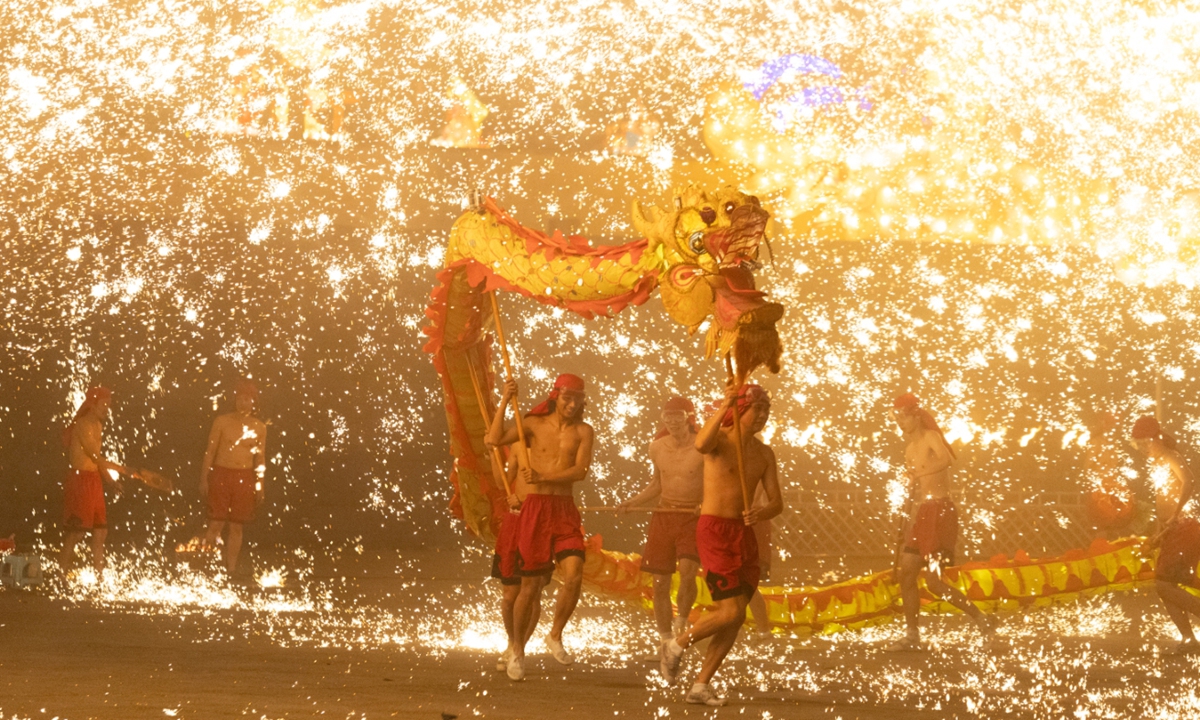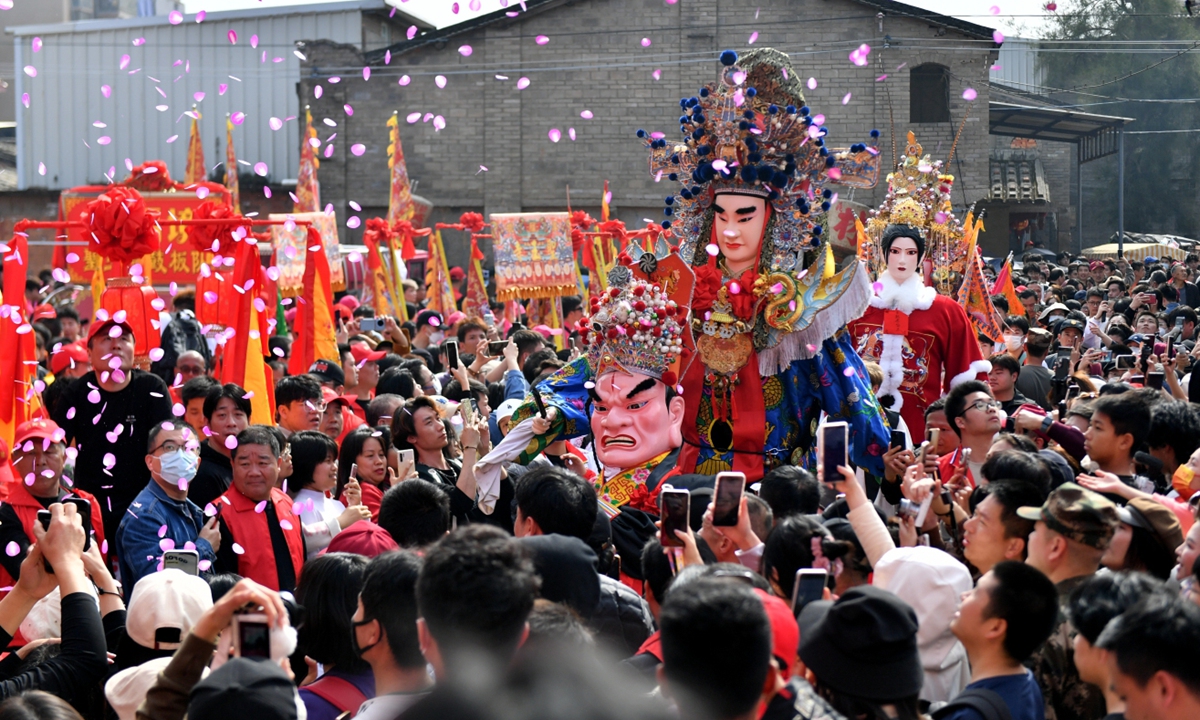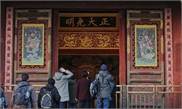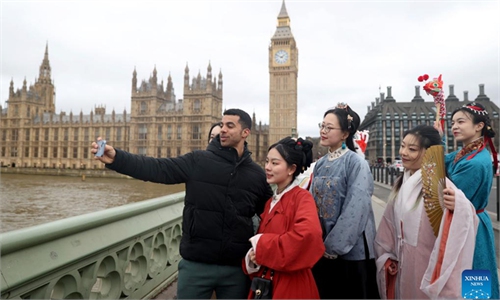ARTS / CULTURE & LEISURE
Young inheritors bring creative changes to China’s Intangible Cultural Heritages

People perform the fire-sparkle dragon dance in Tongliang, Southwest China's Chongqing Municipality. Photo: VCG
Editor's Note:
We would need a whole book if we were to list all of China's prolific Intangible Cultural Heritage (ICH) treasures. Yet there are two special ones among them that have stood out recently: the Youshen tradition in Fujian Province and the "fire-sparkle dragon dance" unique to the Tongliang district of Chongqing. The two folk heritages are special not only due to their high popularity during the recent Spring Festival, but also because they are like "cultural prisms" allowing people to see the creative changes young generation inheritors have brought to China's time-honored folk customs.
Young dragon dancers 'play with fire'
By Li Yuche
The Chinese dragon is without a doubt the central cultural totem of 2024 in China. While the country boasts different types of dragon dances, the Tongliang district of Chongqing Municipality has a special version called the "fire-sparkle dragon dance," which is an ICH performance of "risk" since its splendid visual aesthetics are created by splashing around molten iron.
'Burn marks all over me'
A typical Tongliang dragon dance involves a wave of cheers greeting two dragons who splash around blazing iron sparks as they dance against the black velvety night sky, which accentuates its fiery beauty.
The art demands courage from dancers as they can easily get burned as they splash molten iron from large crucibles around during a performance. Yet, behind the show's glam is a world of perseverance by local fire dragon dancers.
Zhu Huawei, an inheritor of the folk art who undertakes the critical role of producing the fire sparks, told the Global Times that his journey started more than 30 years ago when he was a little kid. Although it was "intimidating" and had "little payoff" at first, Zhu never hesitated for a second about his career choice.
"Melting iron into liquid and creating these sparks is something that took the young apprentice that I was a lot of patience, but I was determined because I'm proud of my culture," Zhu said.
For performances, Zhu keeps a close eye on the molten iron, keeping it at around 1,500 C. During training, he tirelessly conducts tests by throwing spoonfuls of iron into the sky to calculate the exact amount of strength he should use. When done well, the iron should soar about 20 meters into the air, scattering like blossoming flowers.
"Big scars and little burn marks can be found all over my body. It is not an easy dance and also a little bit dicey," Zhu remarked.
Young dancers, new style
With Zhu's efforts, the fire-sparkle dragon dance has drawn more young inheritors' interest over the years. Zhu now has more than 30 apprentices, the youngest only around 17 years old. Zhu said that these young generation performers have brought "new visual aesthetics" to the art.
"Young people are more sensitive about what kind of visual effects appeal to viewers online. So, we invented updated sparks that look even brighter and blazing," said Zhu.
Li Jing, a local dancer who was born in 1999, said that her team has also blended Chinese modern dance elements into the folk art and also redesigned the traditional costumes, decreasing the amount of tawdry decorations while increasing comfort in order to make the whole dance look "classic yet fashionable."
"The 'Tongliang dragon' is not just a performance, but a creative totality of music, handcrafts and athletics. Creativity is the art form's spirit, so our young dancers should carry it on to even younger generations," Fang Hao, a 23-year-old dancer in Tongliang, told the Global Times.
Enlarged show biz
Originating in the Ming Dynasty (1368-1644), the Tongliang dragon dance was just like many Chinese folk heritages that emerged in small-scale village communities dotted around the district. However, its value today extends to local efforts to incorporate it into the district's cultural tourism plans.
According to Zhu, the number of dancers has surged past "a few thousand," and unlike typical 9 am to 5 pm jobs, working as a local dragon dancer has a fluidity that allows many amateurs to join.
"Older dancers were villagers and traders, while younger dancers are students and migrant workers. We only gather together at important performances like the Spring Festival show," Zhu noted.
Other than dance, the dragon performance has nurtured several other sub-markets like the costume designing industry and ICH skill training classes. So far, the dragon culture of Tongliang has brought the district more than 1 billion yuan ($139 million) in growth, said local marketer Xu Longjiang. Xu also noted that the local authority's vision to promote the dance as a cultural brand has made the folk heritage stand out ever further.
"Now the Tongliang dragon performance industry has created employment opportunities for nearly 10,000 local villagers, I'm just only one of them," Zhu told the Global Times.
These efforts haven't just been limited to local authorities, the Development Committee of Culture and Tourism of Chongqing, an even more powerful governmental body, has also supported the vil-lage folk heritage.
In 2021, a cultural tourism campaign called "Nihao! Chongqing," (lit: Hello! Chongqing) was launched by the Committee. The campaign invited international students from more than 20 coun-tries around the world to experience the local Tongliang art. It was a nuanced yet important occasion for letting young foreigners see the cultural diversity of China.
Through such promotional efforts, the local tradition has also managed to debut on more than 30 international stages in Western countries like the US, France and Bulgaria and also Asian countries like Thailand and Singapore.
In 2023, Wang Hao, a performer who was born in the 2000s, brought this indigenous art to Bul-garia. He recalled that the "applause seemed like it was never going to end" and that despite language barriers he managed to communicate with Bulgarian audiences by teaching them how to move and allowed them to pat the dragon's head.
"I am just a village boy who wants show my culture to the world," Wang remarked.

People take part in the traditional folk event known as Youshen, which literally means "Wandering Gods," in a village in East China's Fujian Province.Photo: VCG
Celebrating folk festivals with parade of gods
By Chen Xi
Fujian is one of the provinces with the most temples in the country, with over 1,000 different folk beliefs practiced across the province, each with its own intricate rituals. This begs the question: Why is the Youshen (lit: Wandering Gods) tradition so popular in Fujian, and why do Fujianese worship so many gods?
Youshen culture prevails along the southeastern coastal areas, with Fujian Province being the most prominent. When the time for Youshen arrives, the air reverberates with the sound of drums and firecrackers, transforming villages into bustling hubs of activity. Some liken it to a "walking folk museum."
In traditional Chinese culture, Youshen is an ancient folk ritual that involves praying for the blessings of deities for favorable weather, bountiful harvests and national prosperity. Local cultural experts note that the Youshen tradition, passed down through generations, allows contemporary people to continue the ritual of seeking blessings, thus expressing their hopes for a better life. Today, this distinctive folk culture has been recognized as a local intangible cultural heritage.
Fujian has many deities that locals pray to, a phenomenon experts attribute to Fujian's unique history and geographic location.
Zheng Changling, secretary-general of the China Folk Culture Innovation and Development Center and a research fellow at the Chinese National Academy of Arts, told the Global Times that many people from the Central Plains migrated there during different dynasties, bringing with them distinct cultural beliefs, including various local deities.
Furthermore, Fujian's coastal openness made it a crucial maritime gateway, attracting a convergence of foreign cultures and religions throughout history.
"Many of Fujian's deities were historical figures known for their noble qualities such as bravery, loyalty, and filial piety, making them revered and admired by the masses. Over time, these qualities evolved into deification. Through prayers, these individuals inspired people to work hard and strive for a better life, thus serving a positive role," Zheng said.
Youth inheritance
Recently, some videos showing young people driving sports cars while carrying deity statues, like the goddess of the sea Mazu, or taking deity statues on high-speed trains as part of processions have gone viral on social media. More and more young people are celebrating this traditional folk custom in their own way. These videos have also attracted the interest of many Taiwan compatriots, who expressed an eagerness to experience these activities in person.
Lin Guoping, a professor at the School of Social History at Fujian Normal University, told the Global Times that Youshen, as a shared cultural heritage for people on both sides of the Taiwan Straits, will further enhance a sense of cultural identity among Taiwan compatriots.
Currently, the Youshen tradition has been passed down from the older generation to the hands of the youth, who are infusing it with vibrant vitality.
Lin Guoping said that many young people are participating in Youshen activities due to a desire to experience this folk culture.
In some areas of Fujian Province, activities like "funding by the post-1980 generation, management by the post-1990 generation, and labor by the post-2000 generation" have emerged. As traditional Youshen folk activities gain popularity, village temple culture has attracted the attention of many young people, prompting some to establish deity societies to promote and inherit folk culture.
"We hope to gather young people who love traditional folk culture and want to follow in the footsteps of the older generation to pass down traditional folk culture," said Lin Yating, a post-1990 youth who used to be a drummer and later founded a folk culture society in Fujian Province.
Shared memories
Today, Fujian Province's Youshen culture has also been taken outside the country by overseas Chinese who express their nostalgia through the folk event.
Lin Guoping noted that nostalgia is not just a matter of lip service - it needs tangible carriers, whether it's a house, a type of food, or a folk custom or festival.
Every year on the 10th and 26th days of the first lunar month, Houfu village in the Changle district of Fuzhou, Fujian Province, holds traditional Youshen folk activities.
For Lin Liangping, vice president of the Fukien American Association, memories of the folk activities in Houfu village, which he witnessed as a child, have always lingered in his mind. After more than 30 years, he returned to his hometown for the Chinese New Year, where the lively atmosphere evoked childhood memories.
"In recent years, Youshen activities in the Changle district have earned a reputation overseas, stirring nostalgia among overseas Chinese. Upon hearing that traditional Youshen folk activities were being held in their hometown, many overseas Chinese in the US expressed a desire to return and participate in them," Lin Liangping said, adding that he returned to his hometown with his family and over 200 overseas Chinese to participate in folk activities.
Currently, the Fukien American Association is negotiating to bring the folk event from the Changle district to the US.



